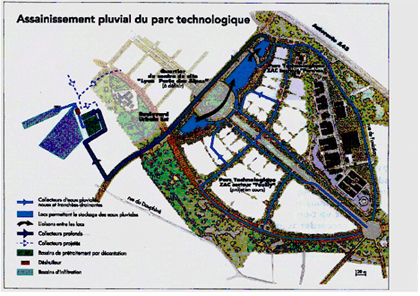 |
 |
 |
 |
 |
 |
 |
 |
 |
 |
 |
 |
Project summary
Name of the case study
Porte des Alpes storm water management.
Where is it located?
France
What type of activity is it?
New urban development.
Short description of the case study
The Porte des Alpes site is considered a strategic site for the development of the city of Lyon. This urban extension project includes a research park, green spaces and a residential area. The project raises storm water management problems due to the saturation of the downstream combined sewer network, relatively low soil permeability over the most of the area and the conservation of groundwater, which is considered as the second supply resource for the city. The solution which has been adopted is to hold back the water and drain it towards areas where permeability allows infiltration, favouring a short storm water cycle offering water management facilities multipurpose objectives.

Rainwater drainage for the technology park
This case study presents sustainable water management and special storm water management solutions for an urban extension site. The area around Lyon where Porte des Alpes is located is characterised by groundwater presence. The project could not have been carried out without introducing technical facilities to protect the aquifer. Indeed this environmental requirement, protection and conservation of groundwater, as groundwater is considered as the second water resource supply for Greater Lyon.
Different tools have been used to assess and manage the storm water infrastructures: environmental indicators, coordination cells and charters. Environmental indicators monitor groundwater, lake ecology and lake purification. The implementation of an operating procedure and responsibilities definition has improved site management.
The case was chosen because it is a pilot site of a Concerted Development Zone (CDZ) and perceived as a showcase for other sites. The CDZ is a public procedure based on concerted objectives and is dependent of an area. It allows public entities to carry out land development who can then give up the land at a later date to public or private users. CDZ allows operation of different sectors that create life in the area: housing, public spaces, roads, economic development etc. CDZ is created, controlled and carried out by the urban community in partnership with the local private economic actors. This approach intends to ensure a concerted management and global operation of the site.
This case study is associated strongly related to the case study Porte des Alpes urban regeneration scheme where the entire urban project is presented.
The PETUS key issues associated with this case study are:
Water - The water resource quality and availability,
Water - Management and conception of urban water infrastructures,
What tools were used to assess sustainability?
Charters and coordination to manage multipurpose facilities
More information